Review: ZingMagic Backgammon versus Odesys Backgammon
Many had been asking for a really good version of Backgammon for S60 for years. And, under the radar, two have appeared in 2007. Can either offer a challenging game?
First up, an old favourite. ZingMagic's Backgammon has been around on previous Symbian platforms and I was reviewing the very latest version, created with more than a nod towards the Nokia E90 that I was testing the games on. Check out the look and feel on the wide screen:
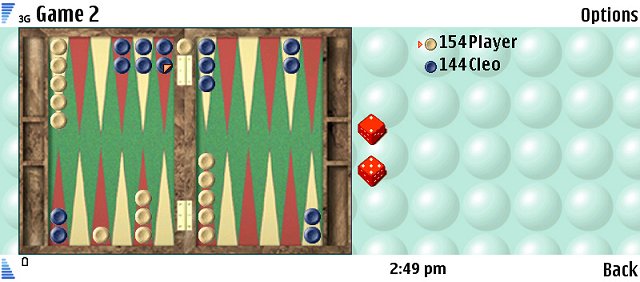
Terrific. There are several combinations of piece and board design and they really show up nicely on the E90. The situation's not so good on traditional portrait QVGA screens though, the playing area/pieces are smaller than they need to be - and switching to landscape mode on the Nokia N93 or N95 surprisingly didn't help, with the board size not being widened accordingly.
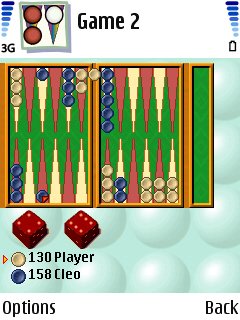 As with most ZingMagic games, you can have multiple games going at once, there's a hint function and an 'Undo' option. Surprisingly, there are no sound effects on offer. Six different computer opponents provide varying levels of opposition, right up to 'whops me every time' difficulty. I should mention at this point that I'm not a bad Backgammon player, though probably not up to club level. But ZingMagic's Backgammon was consistently thrashing me on its hardest level. Even set at its hardest there were no wait times - I guess modern smartphones have enough processing grunt as to not need to flash 'thinking...' at you for more than a second. PIPS scores (giving you an insight into which player is 'ahead') are shown on-screen at all times.
As with most ZingMagic games, you can have multiple games going at once, there's a hint function and an 'Undo' option. Surprisingly, there are no sound effects on offer. Six different computer opponents provide varying levels of opposition, right up to 'whops me every time' difficulty. I should mention at this point that I'm not a bad Backgammon player, though probably not up to club level. But ZingMagic's Backgammon was consistently thrashing me on its hardest level. Even set at its hardest there were no wait times - I guess modern smartphones have enough processing grunt as to not need to flash 'thinking...' at you for more than a second. PIPS scores (giving you an insight into which player is 'ahead') are shown on-screen at all times.
But, aside from the way QVGA screens aren't handled optimally, there's another reason I was a little dissatisfied with ZingMagic's game. As with their chess game, piece selection is handled jerkily, with d-pad directions mapped in a logical fashion to the possible pieces that can be moved. The system's sensible enough and you do get used to it. But what I didn't get used to was the way that the directions are reversed between piece selection and piece destination. So, for example, d-pad right maps to counter-clockwise for piece selection, but maps to clockwise for picking a destination from the possible choices. This reversal doesn't make for smooth gameplay and d-pad right always meaning (e.g.) clockwise in all modes would be much better.
One bug I found was that the 'cursor' is often started on an opponent piece - meaning one extra keystroke per move. Hopefully ZingMagic can fix this at the same time they're attending to the gripe above 8-)
Rating: 74%
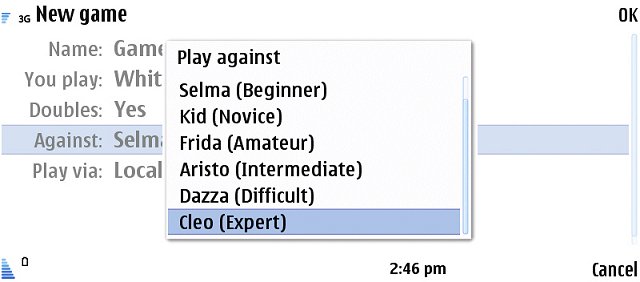
The Second game is Odesys Backgammon, a J2ME game (unlike ZingMagic's, which was a native S60 app). You'll remember that I highlighted the free Lite version a while back? I loved the price (of course) and the interface (perfect handling of piece selection and gameplay) but since then I'd got frustrated that the A.I. of the game wasn't clever enough and that I won every single time.
Investigating the full version (levels 'Normal' and 'Difficult'), I discovered that it was only $4, around £2. Which is low enough to almost qualify as freeware and makes it a complete 'must' for anyone into Backgammon. Playing on the 'Difficult' level, I found that the game beat me regularly and I'd compare its intelligence to the top level on ZingMagic's game.
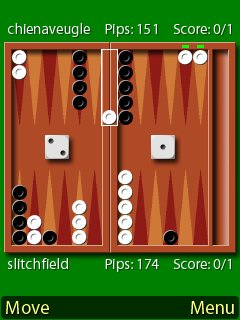
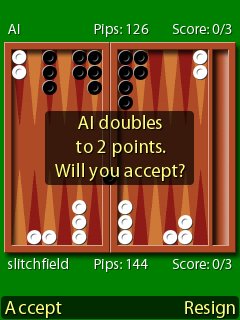
The J2ME environment doesn't scale that well to the Nokia E90's wide screen and I found the game played better in closed mode and on more traditional QVGA portrait smartphones. Screen space is used well and I found the board design and pieces exceptionally clear. Piece selection is intuitive and prediction of your likely destination spaces sensible, so that in many cases you can simply press in the d-pad to accept and kick off the next computer turn.
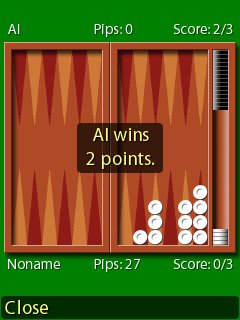
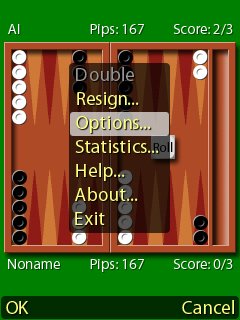
The best thing about Odesys Backgammon isn't related to interface or gameplay though. While ZingMagic's game allows you to play via Bluetooth or even SMS with another player, Odesys' game goes to a whole different level by connecting you to the worldwide FIBS system. Analagous to the N-Gage Arena, it's a platform-independent way of letting you play in real time against players from all over the world. So you start a new 'Online' game and bang, you're shown who's logged in and available to play, along with their FIBS rating.
You can either invite a specific person to play (and then wait for him or her to respond) or simply wait for an invite from someone else. This part can take anything from a few seconds to a few minutes depending on the time of day and what others round the world are doing on their phones and desktop computers, of course. Luckily, Odesys Backgammon has full sound and vibrate capability and you can stick your device back in your pocket and wait for an alert that someone has accepted your invitation or wants to play you. (The same sound support also means that you get the sound of dice rolling while playing - either a nice touch or incriminating evidence to your boss or wife, should you be supposed to be working - sound is thankfully optional!)
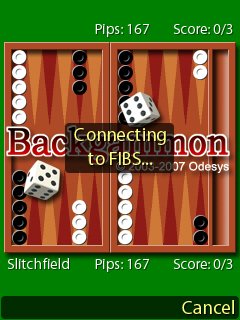
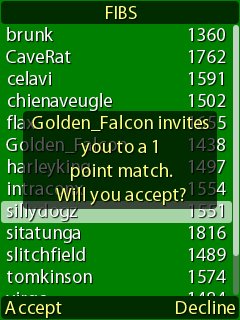
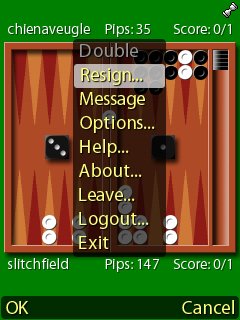
The buzz that comes from knowing that you're not just playing the computer, you're playing a real person who also really wants to show off his skill and win, somewhere else in the world, is difficult to describe. But this online FIBS option sets Odesys Backgammon up as the victor in this double-review. Playing by SMS in ZingMagic's version could quickly get very expensive, whereas the data used by the online FIBS system is trivial - around 20K for an entire game.
A nice extra is that you can chat during the game to the other player, so there's a real sense of interaction. And, at the end of the game, the victor's FIBS rating is adjusted upwards and the loser's downwards. All great fun!
Rating: 92%
Steve Litchfield, AllAboutSymbian, 21 Sep 2007
Reviewed by Steve Litchfield at
